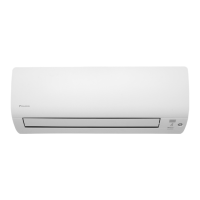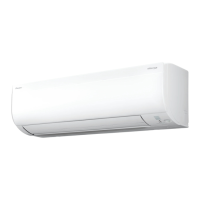Do you have a question about the Daikin FTXM22VVLT and is the answer not in the manual?
Mixes dehumidified cool air with room air to adjust temperature and remove moisture.
Detects human movement and adjusts airflow for energy saving.
Allows saving up to 4 timer settings per day for family lifestyle.
Dries indoor unit to suppress mold generation.
Decomposes mold/allergens for clean air.
Adjusts airflow direction to avoid direct contact with people.
Lowers outdoor unit noise for quiet neighborhood.
Crucial warnings and cautions for safe operation and handling of the unit.
Instructions to prevent injury, fire, electric shock, and property damage.
Guidelines for placement and environment around indoor/outdoor units.
Advice on avoiding damage, injury, and malfunction during use.
Identification of key parts of the indoor unit, including sensors and lamps.
Description of the orange lamp indicating wireless LAN connection status.
Explanation of the LCD display and its settings.
Button for changing the temperature setting.
Button for selecting the airflow rate.
Buttons for powerful operation and wireless LAN connection.
Button for selecting operation modes like AUTO, DRY, COOL, HEAT, FAN.
Controls airflow direction and display brightness.
Buttons for setting ON/OFF timers and cancelling timers.
Instructions for inserting and handling remote controller batteries safely.
Steps for mounting the remote controller holder on a wall.
Guidance on attaching optional air quality filters.
Procedure for turning on the main power via the circuit breaker.
Step-by-step guide to set the current time and day of the week.
How to start and stop the air conditioner by choosing modes like AUTO, DRY, COOL, HEAT, FAN.
Explains how AUTO mode selects operations based on indoor temperature.
Details on heating performance, frost, and defrosting.
Clarifies that FAN mode is for fan-only operation.
How to raise or lower the temperature using the remote control.
How to change the fan speed from AUTO to quiet or specific levels.
Advice on moderate temperature settings, curtains, and filter cleaning.
How to enable automatic swing for vertical flaps.
How to enable automatic swing for horizontal louvres.
How to activate simultaneous swing of flaps and louvres.
How to set flap/louver position during auto swing.
How to enable automatic drying of the indoor unit to prevent mold.
How to activate the streamer for air purification.
How to set airflow direction for comfortable, non-direct blowing.
How the sensor detects movement and adjusts airflow for energy saving.
Explains sensor detection areas and airflow adjustments based on presence.
How the unit enters energy-saving mode based on inactivity.
How to activate maximum cooling/heating effect for 20 minutes.
How to enable power saving or noise reduction modes.
Steps to set the ON or OFF timer using a 24-hour clock display.
Steps to set the OFF timer using a 24-hour clock display.
Example of combining ON and OFF timers.
How to set timers using a countdown display (1-12 hours).
Illustrates how to set timers for weekdays and weekends.
Steps to enter setting mode, select day, number, and mode.
How to select the specific time for weekly timer settings.
How to select the temperature for weekly timer settings.
Final steps to confirm and activate the weekly timer.
How to copy timer settings from one day to another.
How to check the set weekly timer reservations.
Steps to delete a single timer reservation.
How to delete all reservations for a specific day.
How to delete all programmed weekly timer settings.
Introduction to connecting the air conditioner to a wireless network.
Steps to download and install the DAIKIN Mobile Controller app for Android and iOS.
Explains the meaning of the wireless LAN adapter lamp's status.
Overview of connecting via WPS or Access Point connection.
How to turn the wireless LAN adapter on or off using the remote.
Notes regarding the SP-3 menu and how to deactivate it if accidentally activated.
Step-by-step guide to connect via WPS button on the router.
Troubleshooting tips if WPS connection fails.
Steps for connecting directly to the adapter without WPS.
How to reset wireless connection settings to factory defaults.
Quick reference for cleaning the front panel, air filter, and indoor/outdoor units.
Details on types, part numbers, and cleaning/replacement of air filters.
Steps to access the air filters by opening the front panel.
Detailed instructions for removing, cleaning, and reinstalling air filters.
Instructions for inserting different types of filters into the filter frame.
Guidance on cleaning and replacing deodorizing and air quality filters.
Steps to take before storing the unit for extended periods.
Advice on professional maintenance for long-term performance.
Troubleshooting common problems like flaps not swinging or stopping airflow.
Explanations for various sounds like flowing water, ticking, or hissing.
Reasons for water or steam from the outdoor unit during operation.
Checks for issues like no operation or blinking operation lamp.
Troubleshooting sudden stops and blinking lamps.
Checks for issues like continuous operation or outdoor fan rotation after stopping.
Diagnosing problems with insufficient cooling or heating, or no airflow.
Explains mist appearance during cooling operation.
Troubleshooting signal reception, faint/erratic display, or unresponsive remote.
Reasons for odors from the unit and recommended cleaning.
Diagnosing problems with the operation lamp or display brightness.
Troubleshooting when streamer discharge sound stops.
Addressing strange behavior, timer malfunctions, and operating conditions.
How to resolve issues with finding the device or operating from outside.
When to contact a dealer for critical issues like burning smell or abnormal sounds.
How to view error codes on the remote controller for diagnosis.
List of system, indoor, and outdoor unit error codes and their meanings.
Mixes dehumidified cool air with room air to adjust temperature and remove moisture.
Detects human movement and adjusts airflow for energy saving.
Allows saving up to 4 timer settings per day for family lifestyle.
Dries indoor unit to suppress mold generation.
Decomposes mold/allergens for clean air.
Adjusts airflow direction to avoid direct contact with people.
Lowers outdoor unit noise for quiet neighborhood.
Crucial warnings and cautions for safe operation and handling of the unit.
Instructions to prevent injury, fire, electric shock, and property damage.
Guidelines for placement and environment around indoor/outdoor units.
Advice on avoiding damage, injury, and malfunction during use.
Identification of key parts of the indoor unit, including sensors and lamps.
Description of the orange lamp indicating wireless LAN connection status.
Explanation of the LCD display and its settings.
Button for changing the temperature setting.
Button for selecting the airflow rate.
Buttons for powerful operation and wireless LAN connection.
Button for selecting operation modes like AUTO, DRY, COOL, HEAT, FAN.
Controls airflow direction and display brightness.
Buttons for setting ON/OFF timers and cancelling timers.
Instructions for inserting and handling remote controller batteries safely.
Steps for mounting the remote controller holder on a wall.
Guidance on attaching optional air quality filters.
Procedure for turning on the main power via the circuit breaker.
Step-by-step guide to set the current time and day of the week.
How to start and stop the air conditioner by choosing modes like AUTO, DRY, COOL, HEAT, FAN.
Explains how AUTO mode selects operations based on indoor temperature.
Details on heating performance, frost, and defrosting.
Clarifies that FAN mode is for fan-only operation.
How to raise or lower the temperature using the remote control.
How to change the fan speed from AUTO to quiet or specific levels.
Advice on moderate temperature settings, curtains, and filter cleaning.
How to enable automatic swing for vertical flaps.
How to enable automatic swing for horizontal louvres.
How to activate simultaneous swing of flaps and louvres.
How to set flap/louver position during auto swing.
How to enable automatic drying of the indoor unit to prevent mold.
How to activate the streamer for air purification.
How to set airflow direction for comfortable, non-direct blowing.
How the sensor detects movement and adjusts airflow for energy saving.
Explains sensor detection areas and airflow adjustments based on presence.
How the unit enters energy-saving mode based on inactivity.
How to activate maximum cooling/heating effect for 20 minutes.
How to enable power saving or noise reduction modes.
Steps to set the ON or OFF timer using a 24-hour clock display.
Steps to set the OFF timer using a 24-hour clock display.
Example of combining ON and OFF timers.
How to set timers using a countdown display (1-12 hours).
Illustrates how to set timers for weekdays and weekends.
Steps to enter setting mode, select day, number, and mode.
How to select the specific time for weekly timer settings.
How to select the temperature for weekly timer settings.
Final steps to confirm and activate the weekly timer.
How to copy timer settings from one day to another.
How to check the set weekly timer reservations.
Steps to delete a single timer reservation.
How to delete all reservations for a specific day.
How to delete all programmed weekly timer settings.
Introduction to connecting the air conditioner to a wireless network.
Steps to download and install the DAIKIN Mobile Controller app for Android and iOS.
Explains the meaning of the wireless LAN adapter lamp's status.
Overview of connecting via WPS or Access Point connection.
How to turn the wireless LAN adapter on or off using the remote.
Notes regarding the SP-3 menu and how to deactivate it if accidentally activated.
Step-by-step guide to connect via WPS button on the router.
Troubleshooting tips if WPS connection fails.
Steps for connecting directly to the adapter without WPS.
How to reset wireless connection settings to factory defaults.
Quick reference for cleaning the front panel, air filter, and indoor/outdoor units.
Details on types, part numbers, and cleaning/replacement of air filters.
Steps to access the air filters by opening the front panel.
Detailed instructions for removing, cleaning, and reinstalling air filters.
Instructions for inserting different types of filters into the filter frame.
Guidance on cleaning and replacing deodorizing and air quality filters.
Steps to take before storing the unit for extended periods.
Advice on professional maintenance for long-term performance.
Troubleshooting common problems like flaps not swinging or stopping airflow.
Explanations for various sounds like flowing water, ticking, or hissing.
Reasons for water or steam from the outdoor unit during operation.
Checks for issues like no operation or blinking operation lamp.
Troubleshooting sudden stops and blinking lamps.
Checks for issues like continuous operation or outdoor fan rotation after stopping.
Diagnosing problems with insufficient cooling or heating, or no airflow.
Explains mist appearance during cooling operation.
Troubleshooting signal reception, faint/erratic display, or unresponsive remote.
Reasons for odors from the unit and recommended cleaning.
Diagnosing problems with the operation lamp or display brightness.
Troubleshooting when streamer discharge sound stops.
Addressing strange behavior, timer malfunctions, and operating conditions.
How to resolve issues with finding the device or operating from outside.
When to contact a dealer for critical issues like burning smell or abnormal sounds.
How to view error codes on the remote controller for diagnosis.
List of system, indoor, and outdoor unit error codes and their meanings.
| Cooling Capacity | 2.2 kW |
|---|---|
| Heating Capacity | 2.5 kW |
| Outdoor Unit Dimensions (HxWxD) | 550 x 765 x 285 mm |
| Refrigerant | R32 |
| Outdoor Unit Dimensions (WxHxD) | 765 x 550 x 285 mm |
| Energy Efficiency Ratio (EER) | 3.5 |
| Power Supply | 220-240 V, 50 Hz |
| Energy Efficiency Ratio (Cooling) | 3.5 |
| Noise Level (Indoor Unit) | 19 dB |












